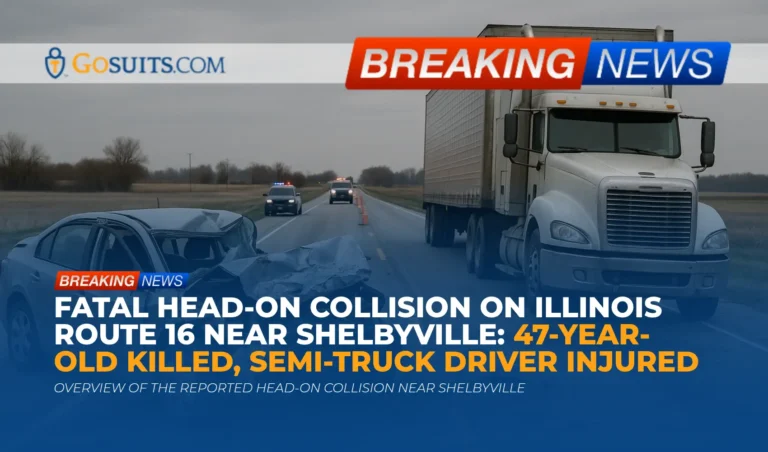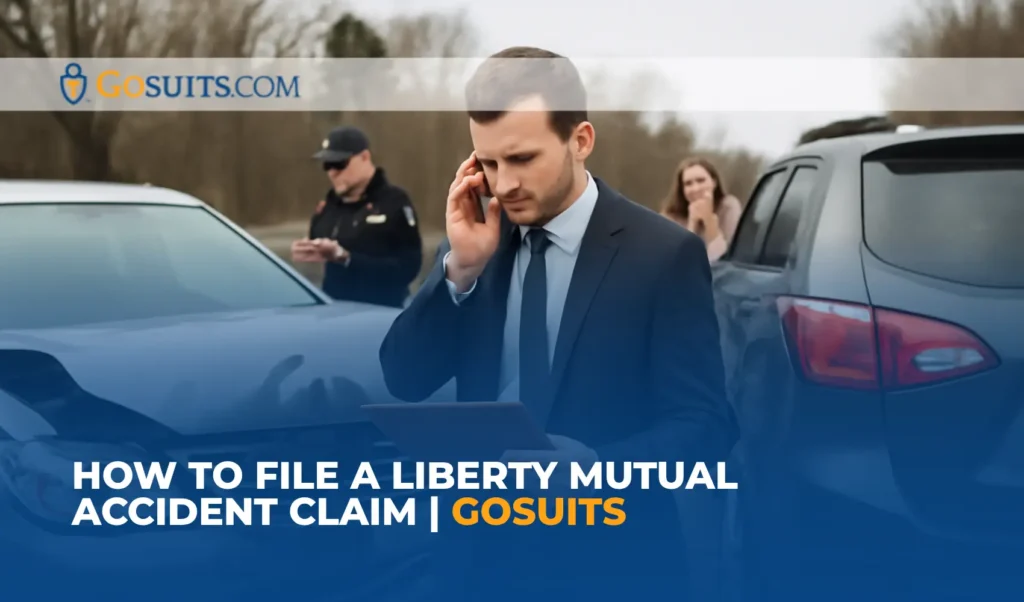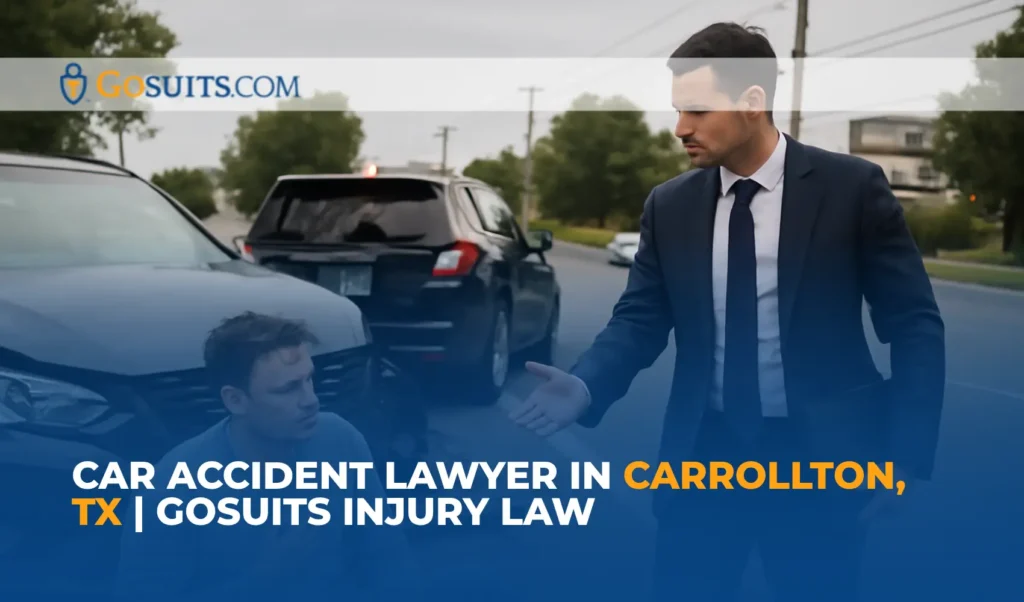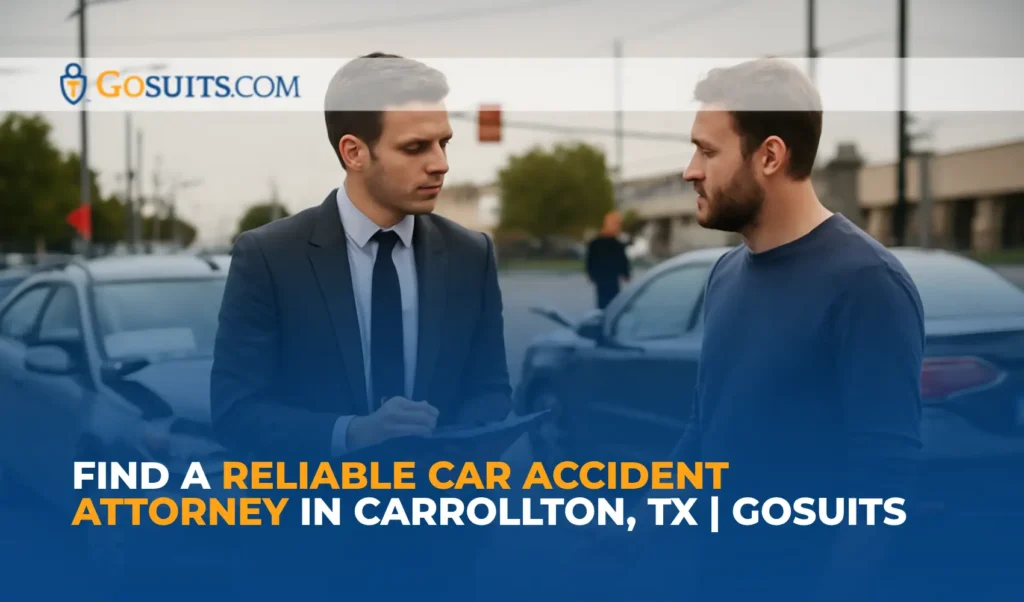- Overview of the reported head-on collision near Shelbyville
- What officials have reported so far
- Head-on collisions: common contributing factors investigators examine
- First steps families often take and who to call for records
- How Illinois law treats fatal motor-vehicle collisions
- Potential civil liability issues in a car vs. semi-truck head-on crash
- Insurance and claims considerations after a fatal crash in Illinois
- Preserving crucial evidence from a semi-truck and passenger vehicle
- Grief, practical logistics, and public records to request
- Typical timeline after a serious Illinois crash
- Data and context: roadway departure and head-on risk
- Why timely action matters: steps to consider now
- Commentary from Gosuits Shelbyville, Illinois Personal Injury Attorney
Overview of the reported head-on collision near Shelbyville
A tragic head-on collision was reported on Illinois Route 16 near Shelbyville on Saturday morning. According to initial statements, Illinois State Police responded to the area of IL-16 at Shelby County Road North 2250 around 9 a.m. A 47-year-old eastbound driver appears to have drifted into the oncoming lane and collided head-on with a semi-truck. There were no passengers reported in either vehicle. The 47-year-old was pronounced deceased at the scene, and the 62-year-old semi-truck driver was transported to a hospital with minor injuries. The highway remained closed during the investigation until approximately 3:14 p.m. Authorities indicated the crash remains under investigation, and the cause of the drift into the oncoming lane has not been determined at this time.
Our hearts are with the family, friends, and community members affected by this loss. The information below is intended to help people understand what typically happens after a serious crash, which agencies may hold important records, and how Illinois civil law generally addresses fatal collisions. It is not a substitute for individual legal guidance.
What officials have reported so far
The initial public account points to the following: law enforcement responded promptly to IL-16 and North 2250 East in Shelby County; preliminary observations indicate the eastbound vehicle crossed the center line; the crash involved a head-on impact with a semi-truck; the driver of the passenger vehicle died at the scene; the semi-truck driver sustained minor injuries; and the roadway was closed for several hours while first responders managed the scene and investigators documented evidence. Investigations of this nature typically involve on-scene measurements, photographs, collision reconstruction, and later, a comprehensive report that may include witness statements, vehicle inspections, and, where relevant, toxicology results.
Because the investigation is ongoing, additional details could emerge in the days and weeks ahead. Families should be aware that final crash reports, coroner findings, and any supplemental documentation can take time to complete, especially where laboratory testing or complex reconstruction analyses are involved.
Head-on collisions: common contributing factors investigators examine
Head-on crashes are among the most severe roadway events because the speeds of both vehicles combine at impact. When a vehicle drifts into oncoming traffic, investigators often consider several potential factors. None of the items below should be taken as conclusions about this specific crash; rather, they represent the kinds of issues typically evaluated.
- Driver condition and attention – Fatigue, distraction, sudden medical events, or impairment are evaluated through interviews, device data, and toxicology where appropriate.
- Vehicle condition – Tire blowouts, steering or brake failure, and other mechanical defects may be checked via post-collision inspections and maintenance records.
- Roadway and environment – Weather, lighting, visibility, lane markings, shoulder condition, and signage may influence lane-keeping and are often documented in the reconstruction.
- Speed and lane position – Skid marks, yaw marks, debris fields, and event data recorders can help estimate speeds and the point of lane departure.
- Commercial vehicle compliance – For a semi-truck, investigators may review driver hours-of-service compliance, inspection and maintenance records, and electronic logging device (ELD) data.
For context, the Federal Highway Administration notes that roadway departure crashes, which include vehicles that cross the centerline into opposing traffic, account for a substantial share of fatalities nationwide. Countermeasures like rumble strips, improved markings, and median barriers are widely used to reduce such events. See Federal Highway Administration roadway safety resources for background on the national safety picture.
First steps families often take and who to call for records
In the aftermath of a fatal collision, families can feel overwhelmed by grief and logistics. The following are practical steps that commonly help in Illinois after a serious crash. Consider consulting an attorney first so communications and record requests are handled thoughtfully and timed appropriately during the investigation.
- Police crash report and supplemental materials – Illinois State Police crash reports can often be requested online. See ISP’s crash report portal: Illinois State Police Crash Reports. Reports may not be immediately available if the investigation is ongoing. Supplemental items like scene photographs or 911 recordings may require a formal request under the Illinois Freedom of Information Act (FOIA), subject to exemptions for active investigations. See 5 ILCS 140 (Illinois FOIA).
- Coroner’s office and autopsy report – In deaths resulting from motor-vehicle crashes, county coroners typically investigate the cause and manner of death and may order an autopsy under the Illinois Coroners and Medical Examiners provisions. See 55 ILCS 5/3-3001 et seq. and specific authority for autopsy at 55 ILCS 5/3-3013. Families can contact the Shelby County Coroner’s Office to ask about timelines for reports and certified copies.
- Death certificate – Certified death certificates are typically obtained through the county clerk or the Illinois Department of Public Health’s Vital Records program. See IDPH information on death records: IDPH Death Records.
- Hospital and EMS records – Where medical care was provided, request hospital records, EMS run sheets, and discharge summaries. These can be important for insurance submissions and understanding injuries.
- Towing and vehicle location – Determine where vehicles were towed for storage. Promptly document the condition of the vehicle before repairs or salvage; preservation can be critical for later inspections.
- Work-related documents (if a commercial vehicle is involved) – If a semi-truck is involved, preserve bills of lading, dispatch notes, and driver duty logs. An attorney can send a preservation notice to the motor carrier to help secure these records.
How Illinois law treats fatal motor-vehicle collisions
Illinois recognizes two related civil claims in fatal crash scenarios: a wrongful death claim and a survival action. These claims serve different purposes and are typically brought by the personal representative of the deceased person’s estate.
- Wrongful death claim – Brought for the benefit of the surviving next of kin based on losses they suffer due to the death (such as loss of society). See the Illinois Wrongful Death Act, 740 ILCS 180. Statutes of limitations apply; in general, actions are to be commenced within the time limits set by the Act. See 740 ILCS 180/2.
- Survival action – Allows the estate to pursue claims the deceased could have brought if they had lived, including pain and suffering between injury and death and certain property damages. See 755 ILCS 5/27-6.
Time limits can vary and may be affected by the status of potential defendants (such as government entities). It is important to review the applicable statutes early to avoid missing deadlines.
Potential civil liability issues in a car vs. semi-truck head-on crash
When a car crosses into opposing traffic and a head-on collision results, liability analysis focuses on why the lane departure occurred and whether any other factors contributed. The early description in this matter indicates the passenger vehicle drifted into the oncoming lane and struck a semi-truck. Investigators and insurers will examine:
- The passenger vehicle’s condition and the driver’s state – Mechanical failures, sudden medical issues, distraction, or fatigue can be relevant to fault determinations. Evidence may include the vehicle’s event data recorder, phone records (if lawfully obtained), and medical information.
- The semi-truck’s operation and compliance – Commercial drivers and motor carriers must follow federal safety rules, including hours-of-service limitations and vehicle inspection and maintenance. See 49 CFR Part 395 (Hours of Service) and 49 CFR Part 396 (Inspection, Repair, and Maintenance). Even when another motorist crosses the center line, investigators still review whether the truck’s speed, lighting, evasive actions, or equipment condition played any role.
- Roadway design and maintenance – If poor markings, inadequate signage, or surface defects are found, separate claims against a responsible public entity may be evaluated, subject to strict notice and timing requirements under Illinois law.
Each of these issues requires careful, fact-driven evaluation. While early reports provide a starting point, a full civil assessment ordinarily depends on the completed police report, physical evidence, and, for commercial vehicles, motor carrier records.
Insurance and claims considerations after a fatal crash in Illinois
Grief can collide with insurance paperwork. The following general points may help families understand the landscape. Because statements to insurers can affect claims, consider speaking with a lawyer first, especially before giving recorded statements or signing releases.
- Estate representation – Insurance claims arising from a fatality are typically handled by the personal representative of the decedent’s estate. Opening an estate through the local probate court allows a representative to request records and address claims on the estate’s behalf.
- Liability coverage – Fault determinations drive which insurers pay. In crashes involving a commercial truck, the motor carrier’s liability policy may be implicated if truck operation contributed. Conversely, if the deceased is determined at fault, the truck driver may bring claims against the deceased’s liability coverage through the estate.
- Uninsured/underinsured motorist (UM/UIM) – UM/UIM coverage can apply in certain scenarios, often through the decedent’s own policy, if an at-fault driver lacks adequate insurance. Policy language and facts matter.
- Medical payments and funeral benefits – Some auto policies provide no-fault medical payments coverage, and limited funeral benefit provisions may exist. Check the declarations page and policy endorsements.
- Recorded statements – Insurance adjusters may request statements early. What is said can be used later. It is prudent to consult counsel before engaging in substantive discussions with any insurer.
- Commercial motor carrier records – Prompt spoliation letters can help preserve ELD data, driver logs, dashcam footage, and maintenance files that might otherwise be overwritten or lost in the ordinary course of business.

Preserving crucial evidence from a semi-truck and passenger vehicle
Modern vehicles and commercial trucks often store electronic data that can be vital in reconstructing a crash. Some of this information is overwritten quickly.
- Passenger vehicle event data recorders (EDRs) – Many passenger vehicles contain EDRs that can record pre-crash speed, brake use, and throttle position. These can be downloaded by trained professionals with the proper tools. Federal rules address certain EDR standards for passenger vehicles. See 49 CFR Part 563.
- Commercial truck ELD and engine control module (ECM) data – Federal hours-of-service compliance is tracked through electronic logging devices, and the ECM may contain limited speed and performance snapshots. Regulations for driver hours and logging are found in 49 CFR Part 395.
- Dashcams and external cameras – Many carriers equip trucks with inward- and outward-facing cameras. Written preservation requests should be sent quickly because video retention windows can be short.
- Physical evidence – Preserving the vehicles before they are repaired or salvaged enables independent inspection of tires, brakes, and steering, as well as documentation of crush patterns, seatbelt usage indicators, and airbag control module data.
- Scene evidence – Skid marks fade and weather can erase debris fields. Early photographs, total station mapping by police, and drone imagery can be critical. If possible, request copies of official scene diagrams with the crash report.
Grief, practical logistics, and public records to request
Alongside mourning, families may need to manage paperwork. The agencies and documents below commonly play a role after a fatal Illinois crash.
- Illinois State Police crash report – Request through ISP Crash Reports. Ask about availability of supplemental reports, diagrams, and photographs.
- County coroner – The coroner’s investigation and autopsy report can provide medical clarity and are often required for certain insurance claims. Relevant authority is found in the Illinois Counties Code at 55 ILCS 5/3-3001 et seq. and autopsy authority at 55 ILCS 5/3-3013.
- Death certificate – Obtain through county processes or the state; see IDPH Death Records.
- FOIA requests – For records like 911 audio, CAD logs, or certain agency documents, use Illinois FOIA where appropriate. Some materials may be withheld during active investigations. See 5 ILCS 140.
- Hospital and EMS providers – Request medical records that document care provided, which can be important for insurance submissions.
Typical timeline after a serious Illinois crash
Timelines vary, but several phases are common:
- First 24–72 hours – Law enforcement documents the scene; vehicles are towed; next of kin notifications are completed; the coroner begins the death investigation; families coordinate immediate needs and may locate insurance information and vehicle storage locations.
- First 2–6 weeks – Police reports are drafted; coroner may await toxicology; insurers open claims; evidence preservation letters should be sent; if a commercial vehicle is involved, early requests for ELD and dashcam retention are time-sensitive.
- 1–6 months – Final crash reports and coroner findings are issued; independent inspections and reconstructions may be conducted; settlement discussions with insurers may begin; an estate may be opened to handle claims properly.
- Longer term – If disputes remain, civil litigation timelines apply. Wrongful death and survival claims are governed by statutes, including limitations in 740 ILCS 180/2. Claims against public entities may have shorter notice requirements.
Data and context: roadway departure and head-on risk
Understanding the broader safety context can help communities and families make sense of how such tragedies fit within statewide and national trends.
- Roadway departure crashes – The Federal Highway Administration reports that roadway departure crashes, a category that includes vehicles crossing the centerline into oncoming traffic, represent a large share of traffic fatalities nationwide. FHWA promotes countermeasures such as centerline rumble strips, enhanced pavement markings, and median barriers. See FHWA’s roadway safety resources: FHWA Roadway Safety.
- Illinois crash trends – The Illinois Department of Transportation publishes annual crash facts and statistics, offering insight into fatal crash causes and patterns statewide. See IDOT Crash Facts and Statistics.
- Seatbelts and survivability – National Highway Traffic Safety Administration materials consistently emphasize the life-saving benefits of seatbelts and the heightened risk associated with frontal impacts. See NHTSA’s annual Traffic Safety Facts reports: NHTSA Traffic Safety Facts.
Local agencies evaluate specific corridors like IL-16 for engineering, enforcement, and education strategies when severe crashes occur, and communities often see safety enhancements implemented where patterns emerge.
Why timely action matters: steps to consider now
The period after a fatal collision is emotionally exhausting. At the same time, important rights and evidence are affected by the passage of time. Without directing this message to any individual, the items below explain why prompt action often matters and what tasks commonly deserve attention.
- Preserve evidence immediately – Vehicle data, dashcam footage, and ELD logs can be overwritten quickly. Written preservation requests are time-sensitive, particularly for commercial carriers.
- Obtain foundational records – Request the police crash report, coroner/autopsy records when available, and death certificates. These documents unlock other processes, including insurance and probate.
- Open an estate when needed – A personal representative can formally handle claims, request records, and protect the decedent’s and family’s interests.
- Consult counsel before insurer contact – Statements to insurers may be recorded and used later. It is prudent to seek a free consultation with a qualified attorney before providing statements or signing any authorizations or releases.
- Calendar deadlines – Illinois statutes set limits for wrongful death and related claims, and special timelines can apply to government entities. Missing a deadline can foreclose rights.
- Coordinate with healthcare providers – Request hospital and EMS records needed for insurance claims and to understand the medical course, even in cases of rapid or on-scene passing.
- Secure personal property – Ensure valuables from the vehicle are collected and documented and that the vehicle’s chain of custody is known while inspections are pending.
Acting in these areas can help ensure critical information is not lost and that decisions are made with a clear understanding of available facts.

Commentary from Gosuits Shelbyville, Illinois Personal Injury Attorney
We extend our deepest sympathies to those grieving after the fatal head-on crash reported near Shelbyville. Losing a loved one so suddenly is devastating. The thoughts here are offered for education and general information to help our communities understand the civil-law and practical steps that often follow a tragedy like this.
Head-on collisions raise urgent questions that an investigation must answer: why did lane departure occur, were there mechanical or medical issues, and did any roadway or commercial-vehicle factors contribute. Even where the initial account suggests one vehicle crossed the centerline, a thorough review of vehicle data, scene evidence, and, in truck cases, motor-carrier compliance is essential before anyone reaches firm conclusions about civil responsibility.
Insurance carriers and large corporations work with complex rules and well-developed playbooks. In the hours and days after a crash, adjusters may seek recorded statements or broad medical authorizations, and commercial carriers may rotate vehicles back into service, risking loss of key data. People unfamiliar with these processes can be at a disadvantage. What someone says early on can affect how a claim is evaluated later, and missing preservation steps can make it harder to reconstruct what happened.
Free consultations exist so families can ask questions, understand timelines, and learn how evidence preservation, insurance communications, and estate procedures typically unfold, without pressure or commitment. Speaking with a seasoned, skilled attorney before engaging with any insurer can help safeguard rights and set a plan for obtaining the reports and records that will ultimately tell the full story of the crash.
Sources
- Illinois State Police – Crash Reports
- 740 ILCS 180 – Illinois Wrongful Death Act
- 740 ILCS 180/2 – Actions and limitations
- 755 ILCS 5/27-6 – Survival action
- 5 ILCS 140 – Illinois Freedom of Information Act
- 55 ILCS 5/3-3001 et seq. – Coroners; Medical Examiners
- 55 ILCS 5/3-3013 – Autopsy authority
- Illinois Department of Public Health – Death Records
- 49 CFR Part 395 – Hours of Service of Drivers
- 49 CFR Part 396 – Inspection, Repair, and Maintenance
- 49 CFR Part 563 – Event Data Recorders
- Federal Highway Administration – Roadway Safety
- IDOT – Crash Facts and Statistics
- NHTSA – Traffic Safety Facts, Annual Reports






